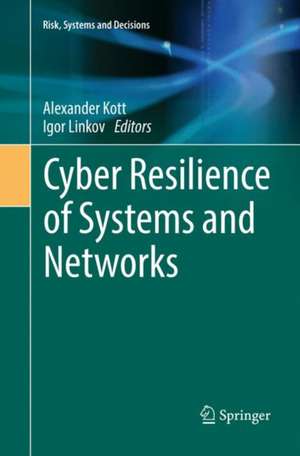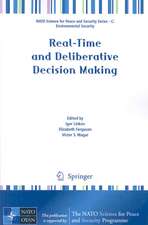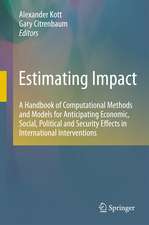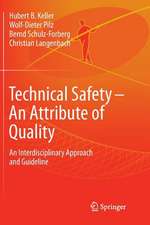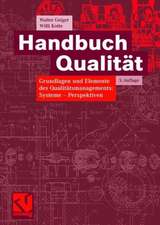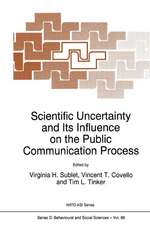Cyber Resilience of Systems and Networks: Risk, Systems and Decisions
Editat de Alexander Kott, Igor Linkoven Limba Engleză Paperback – 19 dec 2018
The book presents insightful discussion of the most current technical issues in cyber resilience, along with relevant methods and procedures. Practical aspects of current cyber resilience practices and techniques are described as they are now, and as they are likely to remain in the near term.
The bulk of the material is presented in the book in a way that is easily accessible to non-specialists. Logical, consistent, and continuous discourse covering all key topics relevant to the field will be of use as teaching material as well as source of emerging scholarship in the field. A typical chapter provides introductory, tutorial-like material, detailed examples, in-depth elaboration of a selected technical approach, and a concise summary of key ideas.
| Toate formatele și edițiile | Preț | Express |
|---|---|---|
| Paperback (1) | 640.67 lei 38-44 zile | |
| Springer International Publishing – 19 dec 2018 | 640.67 lei 38-44 zile | |
| Hardback (1) | 1123.19 lei 6-8 săpt. | |
| Springer International Publishing – 11 iun 2018 | 1123.19 lei 6-8 săpt. |
Preț: 640.67 lei
Preț vechi: 832.04 lei
-23% Nou
Puncte Express: 961
Preț estimativ în valută:
122.59€ • 128.34$ • 101.44£
122.59€ • 128.34$ • 101.44£
Carte tipărită la comandă
Livrare economică 01-07 aprilie
Preluare comenzi: 021 569.72.76
Specificații
ISBN-13: 9783030084677
ISBN-10: 3030084671
Pagini: 475
Ilustrații: X, 475 p. 121 illus., 87 illus. in color.
Dimensiuni: 155 x 235 mm
Ediția:Softcover reprint of the original 1st ed. 2019
Editura: Springer International Publishing
Colecția Springer
Seria Risk, Systems and Decisions
Locul publicării:Cham, Switzerland
ISBN-10: 3030084671
Pagini: 475
Ilustrații: X, 475 p. 121 illus., 87 illus. in color.
Dimensiuni: 155 x 235 mm
Ediția:Softcover reprint of the original 1st ed. 2019
Editura: Springer International Publishing
Colecția Springer
Seria Risk, Systems and Decisions
Locul publicării:Cham, Switzerland
Cuprins
Chapter 1. Introduction.- Part 1. Quantifying Cyber Resilience.- Chapter 2. Metrics Based on the System Performance Perspective.- Chapter 3. Metrics Based on the Mission Risk Perspective.- Part 2. Assessment and Analysis of Cyber Resilience.- Chapter 4. Frameworks and Best Practices.- Chapter 5. Analysis of Dependencies.- Chapter 6. Applying Percolation Theory.- Chapter 7. Modeling the Impact of Cyber Attacks.- Chapter 8. Modeling and Simulation Approaches.- Part 3. Enhancing Cyber Resilience.- Chapter 9. Systems Engineering Approaches.- Chapter 10. Defense Techniques.- Chapter 11. Managing Human Factors.- Chapter 12. Rule-Making for Insider Threat Mitigation.- Chapter 13. Biologically Inspired AI Techniques.- Chapter 14. Economic Effectiveness of Mitigation and Resilience.- Part 4. Cyber Resilience in Selected Classes of Systems and Networks.- Chapter 15. Regional Critical Infrastructures.- Chapter 16. Internet of Things.- Chapter 17. Smart Cities.- Chapter 18. Transportation Networks.- Chapter 19. Supply Chains.
Notă biografică
Dr. Alexander Kott serves as the Chief, Network Science Division, Army Research Laboratory headquartered in Adelphi MD. In this position, he is responsible for fundamental research and applied development in performance and security of both tactical mobile and strategic networks. He oversees projects in network performance and security, intrusion detection, and network emulation.
Between 2003 and 2008, Dr. Kott served as a Defense Advanced Research Programs Agency (DARPA) Program Manager responsible for a number of large-scale advanced technology research programs. His earlier positions included Technical Director with BBN Technologies, Cambridge, MA; Director of R&D at Logica Carnegie Group, Pittsburgh, PA; and IT Research Department Manager at AlliedSignal, Inc., Morristown, NJ. Dr Kott received the Secretary of Defense Exceptional Public Service Award and accompanying Exceptional Public Service Medal, in October 2008.
He earned his PhD from the University of Pittsburgh, Pittsburgh PA in 1989; published over 70 technical papers; and co-authored, and edited six technical books.
Dr. Igor Linkov is the Risk and Decision Science Focus Area Lead with the US Army Engineer Research and Development Center. He is an Adjunct Professor of Engineering and Public Policy at Carnegie Mellon University and Professor of Practice in Electrical and Computer Engineering at the University of Connecticut. Dr. Linkov has managed multiple risk assessments and risk management projects in the areas of environmental management, cybersecurity, critical infrastructure, climate change, and systems vulnerability. He is currently developing resilience assessment and management approaches for infrastructure and cyber systems. As a one of the leaders of the USACE Resilience PDT, he is working on developing the USACE Resilience Roadmap and is part of several Interagency Committees and Working Groups tasked with developing resilience metrics and resilience management approaches. He has published widely on environmental policy, environmental modeling, and risk analysis, including fourteen books and over 250 peer-reviewed papers and book chapters. Dr. Linkov is Society for Risk Analysis Fellow and recipient of 2005 Chauncey Starr Award for exceptional contribution to Risk Analysis and 2014 Outstanding Practitioner Award.
Between 2003 and 2008, Dr. Kott served as a Defense Advanced Research Programs Agency (DARPA) Program Manager responsible for a number of large-scale advanced technology research programs. His earlier positions included Technical Director with BBN Technologies, Cambridge, MA; Director of R&D at Logica Carnegie Group, Pittsburgh, PA; and IT Research Department Manager at AlliedSignal, Inc., Morristown, NJ. Dr Kott received the Secretary of Defense Exceptional Public Service Award and accompanying Exceptional Public Service Medal, in October 2008.
He earned his PhD from the University of Pittsburgh, Pittsburgh PA in 1989; published over 70 technical papers; and co-authored, and edited six technical books.
Dr. Igor Linkov is the Risk and Decision Science Focus Area Lead with the US Army Engineer Research and Development Center. He is an Adjunct Professor of Engineering and Public Policy at Carnegie Mellon University and Professor of Practice in Electrical and Computer Engineering at the University of Connecticut. Dr. Linkov has managed multiple risk assessments and risk management projects in the areas of environmental management, cybersecurity, critical infrastructure, climate change, and systems vulnerability. He is currently developing resilience assessment and management approaches for infrastructure and cyber systems. As a one of the leaders of the USACE Resilience PDT, he is working on developing the USACE Resilience Roadmap and is part of several Interagency Committees and Working Groups tasked with developing resilience metrics and resilience management approaches. He has published widely on environmental policy, environmental modeling, and risk analysis, including fourteen books and over 250 peer-reviewed papers and book chapters. Dr. Linkov is Society for Risk Analysis Fellow and recipient of 2005 Chauncey Starr Award for exceptional contribution to Risk Analysis and 2014 Outstanding Practitioner Award.
Textul de pe ultima copertă
This book introduces fundamental concepts of cyber resilience, drawing expertise from academia, industry, and government. Resilience is defined as the ability to recover from or easily adjust to shocks and stresses. Unlike the concept of security - which is often and incorrectly conflated with resilience -- resilience refers to the system's ability to recover or regenerate its performance after an unexpected impact produces a degradation in its performance. A clear understanding of distinction between security, risk and resilience is important for developing appropriate management of cyber threats.
The book presents insightful discussion of the most current technical issues in cyber resilience, along with relevant methods and procedures. Practical aspects of current cyber resilience practices and techniques are described as they are now, and as they are likely to remain in the near term.
The bulk of the material is presented in the book in a way that is easily accessible to non-specialists. Logical, consistent, and continuous discourse covering all key topics relevant to the field will be of use as teaching material as well as source of emerging scholarship in the field. A typical chapter provides introductory, tutorial-like material, detailed examples, in-depth elaboration of a selected technical approach, and a concise summary of key ideas.
Caracteristici
Provides comprehensive, structured treatment of the subject in a logical, consistent, continuous discourse, covering all key topics relevant to the field. Provides easy-to-read introductions, summaries, and practical observations in each chapter Written for both practitioners and advanced researchers of cyber resilience. Contains the most cutting-edge research and development work on the topic, which also covering the current methods and approaches. The first comprehensive book to focus on technical approaches to building and operating cyber -resilient systems and network. Focuses on innovative solutions that can be applied to cyber-sensitive infrastructures over the next few decades, along with near-term solutions Clearly explain relations and differences between risk resilience and other important properties of complex networks, such as risk, robustness and reliability – frequently and incorrectly confused with resilience Integrates practical and advanced research perspectives of this rapidly evolving field, by bringing authors with extensive academic research experiences as well as practitioners responsible for day-today defense of computer networks against highly sophisticated attackers
